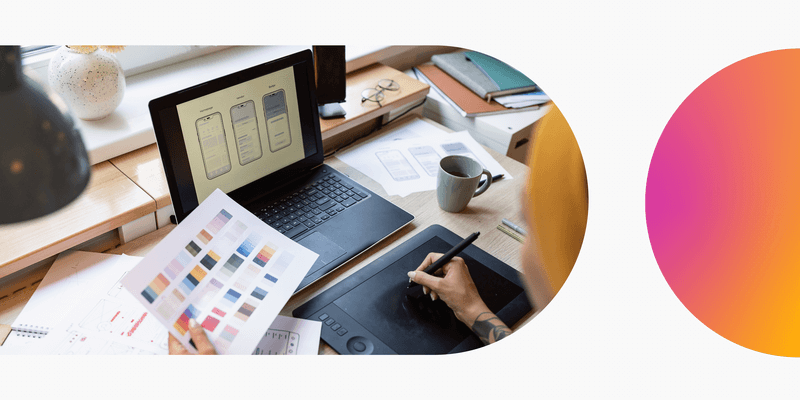When applying for product design (UX/UI) roles, the standard application essentials still matter—a strong resume and a thoughtful cover letter. But in this field, there’s one element that can truly set you apart: your portfolio. As a product designer, your portfolio isn’t just a nice-to-have—it’s often the deciding factor in whether you land the job.
In this guide, we show you how to create the perfect portfolio, from what you should include in it to best practices. We also have a step-by-step plan for creating a great portfolio that will speak to potential employers or clients. Let’s get started.
Why do you need a product design portfolio?
A product design portfolio is a collection of your best work. This includes one to five case studies that will showcase your skills. process and design thinking to potential employers. A full 90% of hiring managers said that entry-level candidates need a strong portfolio when applying to jobs, as per the State of UX Hiring Report.
That means a professional portfolio is a must-have for a product designer, but it doesn’t mean you need a lot of case studies. Quality is far more important than quantity. Even just one great project can make a difference.
As Eoghain Cooper, Senior Career Advisor at the UX Design Institute, says, “Your portfolio is your first real opportunity to show hiring managers what you’re capable of, but you don’t need loads of projects. One or two case studies are enough to get your foot in the door, as long as they’re well thought-out and communicated.”
What should you include in your product design portfolio?
A great product design portfolio should include several key sections.
Home page
Purpose: To highlight what kind of product designer you are
Key component: This is like your elevator pitch, a brief introduction that explains what you do and how you do it.
About Me page
Purpose: Showcase your passion for the field
Key component: This should pick up the story of what kind of designer you are from the home page and demonstrate your passion for product design in the process. This is a longer section that can explain why you’re a product designer, your history in the profession, and your design philosophy. You should also showcase what you love about product design.
Product Design Case Studies
Purpose: To show your skills in action
Key component: Showcase your best and most successful projects in this section; one project equals one case study. You should show each project in detail, through text and visuals, including:
- The initial goals
- What your role on the team was
- Any research that was done
- How you turned research insights into product ideas
- The final product
You should include sketches, photos, wireframes, prototypes, user interfaces, and anything else that helps explain these components.
Contact information
Purpose: Provide contact details
Key component: The contact information section’s purpose is simple: provide contact details so hiring managers can contact you.
How to create an impressive product design portfolio (step-by-step)
Step 1: Choose a portfolio-building platform
Nowadays, your product design portfolio will be expected to be online, so you should have a professional website dedicated to your portfolio. If you happen to be proficient with HTML and CSS, then you can build your portfolio from scratch, but if not there are plenty of all-in-one portfolio builders out there, including Wix, Weebly, UXfolio, and Squarespace. You can see the top UX portfolio builders here.
To choose a platform, look at things like price, customisation, and ease of use. And make sure it’s easy to update on the platform you choose, as you’ll want to keep your product design portfolio up-to-date with your most recent projects.
You should include between one and five case studies. These should be accessible via a “Portfolio” link or included somewhere else on the home page.
Either way, you want to make sure that it’s easy to choose between these case studies and navigate to the individual projects. Your best and latest project should be in the most prominent position.
Step 3: Tell the story of each product design case study
For each case study, you want to tell the story of the project from beginning to end. Set the scene by describing the project, the team, and your role; while the focus should be on you, don’t forget about the other team members, especially if one of them did something especially noteworthy.
After establishing the project, explain the user research you did, the users’ pain points you were trying to address, and showcase how you solved the challenge. Don’t forget to wrap up with screenshots or gifs of the final, polished design and what you learned from the results.
Each case study should have a relatively similar structure so your portfolio is easy to navigate and user friendly.
Step 4: Write the copy for your home and About Me pages
As soon as you land on your product design portfolio’s home page you should get an idea of who you are and what you’re about. This should be done in one to three sentences that leave people wanting more.
This should then be expanded upon in the “About Me” page, where you’ll explain more about who you are, including your professional history, your background, and your professional goals. This should also include an idea of what you’re passionate about as a designer.
The copy should be no more than two to four paragraphs. Prepare to do several drafts before landing on the copy you’ll use.
Step 5: Make sure your visuals give a sense of who you are
From a photo of you on your homepage to pictures of your projects in your case studies, you should bring your own sense of aesthetics to your portfolio. Keep it professional and easy-to-use but, remember, this is your portfolio, so feel free to get creative.
Step 6: Include your contact details
Include your contact information somewhere in your portfolio. This could be done by including your email address and social media icons on the bottom of every page or by including a “Contact Me” page that includes a contact form and email address.
Step 7: Test and publish
You wouldn’t publish a project you worked on without some user testing, and that should be the same for your portfolio. Ask friends, family, and colleagues to give feedback on the final product and make suggestions for improving how things look and function. Have them look for broken links and typos, and make sure that everything is easy to navigate. Then update your portfolio based on their feedback.
When you’re ready, hit the publish button and your portfolio will go live!
Also read: How to create the best UI design portfolio: 10 tips and best practices
5 product design portfolio best practices
Here are some additional tips and best practices to make sure your portfolio is its very best:
1. Keep your portfolio up-to-date
Your portfolio should be a showcase for your work for the stage of your career you’re at, not the stage you were at a year ago. Make sure to keep your portfolio up-to-date as you evolve as a designer.
In fact, you may want to start an outline for a case study as each new project begins, so you can get the case study written and up on your website as soon as possible. This will also help you keep track of things like data points, objectives, and users’ pain points as the project goes along. You may end up tossing the whole thing depending on how the project goes, but if you use it, the extra time you’ll save will be invaluable.
2. Show the final product at the top of each case study
While you will be telling the story of each project, start each case study with a screenshot or GIF of the final product, so hiring managers will have that “wow” factor right away. You can then go back and show them artefacts from earlier in the project, but they should first know why they’re scrolling. Images of the final product, along with some bullet points about the basics of the project and your role in it, will do the trick.
3. Include no more than five projects in your portfolio
You should include between one and five case studies in your product design portfolio. Two to three is ideal if you’re just starting out, but you should never have more than five case studies of your very best work. A hiring manager is busy, and therefore, won’t spend more than a few minutes on a portfolio. Thus, they won’t have the time to take in more than five projects.
Your portfolio should grow with you and the stage of your career you’re at, so purge your portfolio of older projects and just keep the best newer projects in it.
4. Make sure your portfolio is user-friendly
If your product design portfolio website is difficult to follow, you’ll drive away potential clients and employers. To avoid this, make sure your portfolio prioritises usability, including ease of navigation, clarity, and accessibility. Make sure your content is broken into short, skimmable paragraphs and that you use clear language throughout.
5. Know your audience
Your product design portfolio should be optimised for your ideal audience. This will be the hiring managers or creative directors who are hiring at each company you apply to. As was pointed out earlier, these individuals are busy. Therefore your portfolio should highlight the most important information about you in the least amount of time, ensuring they get an impression of you and your work.
Also read: Your ultimate UX portfolio presentation guide
How to get projects for your product design portfolio if you’re new to the field
If you’re an entry-level product designer and a newcomer to the industry, you still need a product design portfolio. So what can you do to get projects for a portfolio when you have little or no practical experience?
1. Freelance projects
Offer your services to a small business or a non-profit through personal referrals or freelance platforms. Once you’ve completed the project, you’ll have a lovely addition to your portfolio.
2. Personal projects
Create your own project for an existing website, app, or other digital product or identify a gap in the market and create a project around that. The project may not be real, but it will still showcase the skills you need to get a job.
3. Take a professional product design course
Take a course, such as the UX Design Institute’s Product Design Programme. Not only will you learn everything you need to know about product design, you’ll complete at least two to three projects that will be perfect for your portfolio.
Key takeaways
Here are some key takeaways from this guide:
- 90% of hiring managers say a portfolio is important for entry-level product design candidates
- Your portfolio should prize quality over quantity.
- You should include a home page, an ‘About Me’ page, product design case studies, and contact information in your portfolio.
- To create an impressive product design portfolio you’ll want to: choose a portfolio building platform; design your case studies’ navigation; tell the story of each product design case study; write the copy for your home and ‘About Me’ pages; Make sure your visuals give a sense of who you are; Include your contact details; Test and publish.
- Product design portfolio best practices include keeping your portfolio up-to-date, showcasing the final product at the top of each case study, including no more than five projects in your portfolio, ensuring your portfolio is user-friendly, and knowing your audience.
- To get projects for your product design portfolio, you can either do freelance projects, personal projects, or take a professional product design course.
Learn more about product design
For further product design career tips and industry insights, take a look at these blogs: How to incorporate user feedback in product design (and why it matters), 3 tips for product designers: An interview with Emmet Connolly, VP of Product Design at Intercom, and What separates great designers from good ones? An interview with Adam Glynn-Finnegan, Staff Product Designer at Netflix Studio.
You might also like watching the following conversation with Canva’s Hugo Welke on building a career in product design:





![The 10 best prototyping tools for UI/UX designers [2025 Update] 4 UI UX prototyping tools header image](png/93_ux_prototyping-tools_illustration_blog-1.png)